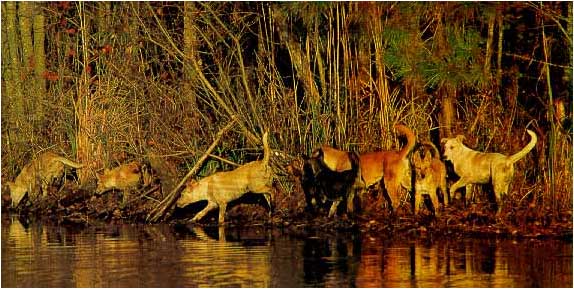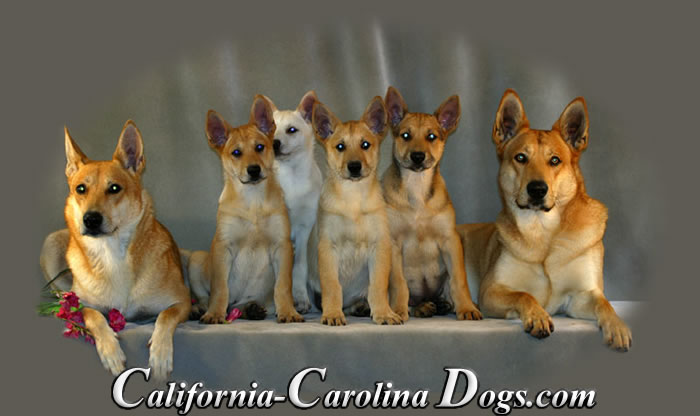“Tracking America's Native Breed”
Copyright 1999 Smithsonian Magazine
All photos by Lynda Richardson
ARTICLE PAGE 1 2 3 4 5

Many explorers said they could scarcely tell the difference between a wolf and a Plains dog, which was well-known for its ability to drag heavy loads for humans.
"There's no doubt that the dog is closest to the wolf," says Juliet Clutton-Brock of the Natural History Museum of London, and one of the world's foremost authorities on the prehistory of domestic animals. Studies since the 1950s reveal many similarities between wolf and dog morphology and behavior, and experts have formed a consensus: the more than 400 breeds of domestic dog, from Chihuahuas to Saint Bernards, were descended from one of the small, southern Asian subspecies of the gray wolf-perhaps the Arabian wolf, or the Indian wolf immortalized by Rudyard Kipling..
The oldest fossils of what are undisputedly dogs date from about 11,000 or 12,000 years ago in Southwest Asia, making dogs the oldest of all domesticated animals. Archaeozo-ologists-scientists who study the remains of animals in association with humans-assumed that the domestication process would have started much earlier, perhaps 15,000 years ago, in conjunction with the rise of permanent villages and the advent of agriculture.
But in 1997, a team led by evolutionary biologists from the University of California at Los Angeles dropped a bombshell. After analyzing DNA from wolves and wild canids around the world, as well as from nearly 70 breeds of dogs, they concluded that dogs and wolves probably split off from each other originally more than 100,000 years ago-almost the same time that anatomically modern humans were first emerging, and long before anyone suspected domestication was possible. While hailed by some molecular biologists, the UCLA findings have been questioned by paleontologists and archaeozoologists. Last August, at a symposium on the history of the domestic dog at the University of Victoria in British Columbia, sponsored by the International Council for Archaeozoology, the controversy was a major topic.
One explanation that might reconcile the archaeological record and the DNA findings is that the dogs ancestors were wolves that split off from other wolf lineages 100,000 years ago, even though dogs themselves didn't evolve until more recently.
While debate swirls around the timing of dog domestication, some experts are taking aim at the fundamental notion that dogs and other animals were domesticated through a human-directed process.
"The standard explanation of how domestication began-that people brought in young wild animals, which they tamed and bred over many years to produce domestic stock-is a myth," argues archaeozo-ologist Susan Crockford, an expert on the Northwest wool dog, and the organizer of the Victoria symposium.
For quite a while, biologists have believed that domestication took place over a long time: a period that would cover taming an animal, molding it from a wild form into a physically and behaviorally different creature. That transition period should provide lots of intermediate forms in the archaeological record-only it doesn't. Instead, the bones of dogs suddenly pop up in archaeological sites about 12,000 years ago, at the same time humans were abandoning their hunter-gatherer culture.
Whether you're talking about dogs, sheep, cows, goats, pigs or water buffalo, there are consistent differences between the wild and domesticated forms. Compared with their wild cousins, most domestic mammals tend to be smaller, have shorter snouts, smaller brains and are more likely to be piebald or solid in color; they are more docile, reproduce at a younger age, have larger litters and have reproductive schedules, such as multiple breeding seasons in a single year, that differ from those of wild animals. Such changes also occur in domestic birds.
Interestingly, all these differences are a consequence of changes in developmental rates, especially while the animal is young, which result in a sexually mature adult with the size and some of the characteristics of a juvenile of its ancestors condition known as paedomorphosis. And those developmental rates, in turn, all appear to be controlled directly or indirectly by a single biochemical: thyroxine, a hormone produced by the thyroid gland, which in turn regulates a suite of crucial growth and developmental genes. Thyroxine, Crockford believes, was the key to domestication changes.
Crockford theorizes that in a sense, wild canids domesticated themselves. By creating a new environment, one in which food supplies were available to those wolves able to tolerate the presence of people, humans set the stage for rapid evolution. Fear is controlled, in part, by the adrenal gland, and adrenaline production, in turn, is one of the many biological functions controlled by thyroxine.
In Crockford's view, the less fearful wolves would thrive near settlements, scavenging garbage middens and filching meat from drying racks, breeding among themselves and reinforcing those attributes. Natural selection would favor canids with thyroxine levels that produce lower adrenal response. Any pups born with a more fearful nature would simply drift away from the villages, back into the wilderness. After just a few generations, she believes, the wolves living near humans would exhibit reproductive, physical and behavioral differences, triggered by their new thyroxine patterns, that would set them apart from their wilder counterparts. They would have become primitive dogs. Only much later, long after primitive dogs had become genetically distinct and reproductively isolated from wolves, did humans begin exerting artificial selection to create distinct breeds
"It may have taken only about 40 years, at two years per generation, for wolves to evolve into early dogs-perhaps more than that, but we can now look at that number as some sort of minimum. And 40 years is almost certainly too fast to pick up intermediate stages in the archaeological record", Crockford argues.
"It may have taken only about 40 years, at two years per generation, for wolves to evolve into early dogs-perhaps more than that, but we can now look at that number as some sort of minimum. And 40 years is almost certainly too fast to pick up intermediate stages in the archaeological record", Crockford argues.
Which brings us back to the Carolina dogs. Are they, as some people claim, a direct link to the aboriginal past, or a recent construct of the canine melting pot?
Brisbin will keep working toward a major genetic study of the dogs. He also hopes to track wild Carolinas by fitting them with radio collars, to learn more about their habits, territory and prey
But even if further research proves the Carolina is of modern origin, it still has much to tell us about natural selection and how, in a relatively short time, stray dogs were molded into an animal well suited to the wet, hot coastal plain of the Southeast. And that lesson alone, Brisbin and other researchers believe, makes this shy, lovely animal worthy of study and conservation.
End of Article...BACK TO HOME PAGE
